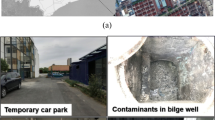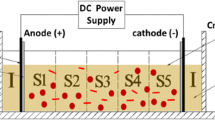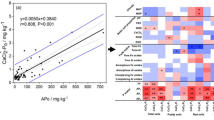Abstract
Purpose
Acid rain can accelerate the acidification of the chromium-contaminated soils, resulting in chromium releasing into soil solution and causing ecological risk. The current study aims to investigate the release of chromium in the remedied soils by Pannonibacter phragmitetus BB under the simulated acid rain leaching and to assess its risk to groundwater.
Materials and methods
P. phragmitetus BB was utilized to remedy the Cr(VI)-contaminated soils at two levels (80 and 1,276 mg kg−1) by the column leaching experiment, and the chemical remediation with ferrous sulfate was used as a control. The remedied soils by P. phragmitetus BB and ferrous sulfate were leached under the simulated acid rain to evaluate the release of chromium. Furthermore, the risk of chromium release from the remedied soils to the groundwater was assessed by a fuzzy comprehensive evaluation method.
Results and discussion
The average concentrations of water-soluble Cr(VI) in the remedied soils by P. phragmitetus BB were reduced to less than 5.0 mg kg−1. Under leaching situation with the simulated acid rain, the release of total chromium and Cr(VI) from the remedied soils by P. phragmitetus BB and ferrous sulfate declined rapidly with the extended leaching time. However, the release amounts of total chromium and Cr(VI) from the remedied soil by P. phragmitetus BB more efficiently deceased as compared with that by ferrous sulfate remediation. Carbonate-bounded, exchangeable, and organics-bonded chromium were the major chromium-releasing sources under the simulated rain leaching. After microbial remediation with P. phragmitetus BB and chemical remediation with ferrous sulfate, the risk grades of the remedied soils to groundwater declined from classes 11 to 5 and 6, respectively.
Conclusions
The risks of the remedied soils by both microbial remediation with P. phragmitetus BB and chemical remediation with ferrous sulfate to groundwater effectively decreased and microbial remediation more significantly declined the chromium risk to groundwater than chemical remediation.






Similar content being viewed by others
References
Blake L, Goulding K (2002) Effects of atmospheric deposition, soil pH and acidification on heavy metal contents in soils and vegetation of semi-natural ecosystems at Rothamsted Experimental Station, UK. Plant Soil 240:235–251
Cervantes C, Campos-García J (2007) Reduction and efflux of chromate by bacteria. Microbiol Monogr 6:407–419
Chai L, Huang S, Yang Z, Peng B, Huang Y, Chen Y (2009) Cr(VI) remediation by indigenous bacteria in soils contaminated by chromium-containing slag. J Hazard Mater 167:516–522
Dermatas D, Chrysochoou M, Moon DH, Grubb DG, Wazne M, Christodoulatos C (2006) Ettringite-induced heave in chromite ore processing residue (COPR) upon ferrous sulfate treatment. Environ Sci Technol 40:5786–5792
Dianwu Z, Seip HM (1991) Assessing effects of acid deposition in southwestern China using the MAGIC model. Water Air Soil Pollut 60:83–97
Dong D, Zhao X, Hua X, Liu J, Gao M (2009) Investigation of the potential mobility of Pb, Cd and Cr(VI) from moderately contaminated farmland soil to groundwater in Northeast, China. J Hazard Mater 162:1261–1268
Földi C, Dohrmann R, Matern K, Mansfeldt T (2013) Characterization of chromium-containing wastes and soils affected by the production of chromium tanning agents. J Soils Sediments 13(7):1170–1179
Garnier J, Quantin C, Martins E, Becquer T (2006) Solid speciation and availability of chromium in ultramafic soils from Niquelândia, Brazil. J Geochem Explor 88:206–209
Graham MC, Farmer JG, Anderson P, Paterson E, Hillier S, Lumsdon DG, Bewley RJF (2006) Calcium polysulfide remediation of hexavalent chromium contamination from chromite ore processing residue. Sci Total Environ 364:32–44
Haiyan W (2002) Assessment and prediction of overall environmental quality of Zhuzhou City, Hunan Province, China. J Environ Manage 66:329–340
Huang S, Peng B, Yang Z, Chai L, Xu Y, Su C (2009) Spatial distribution of chromium in soils contaminated by chromium-containing slag. T Nonferr Metal Soc 19:756–764
Icaga Y (2007) Fuzzy evaluation of water quality classification. Ecol Indic 7:710–718
Jagupilla SC, Moon DH, Wazne M, Christodoulatos C, Kim MG (2009) Effects of particle size and acid addition on the remediation of chromite ore processing residue using ferrous sulfate. J Hazard Mater 168:121–128
Kim K, Choi W (2011) Enhanced redox conversion of chromate and arsenite in ice. Environ Sci Technol 45:2202–2208
Kumpiene J, Ore S, Renella G, Mench M, Lagerkvist A, Maurice C (2006) Assessment of zerovalent iron for stabilization of chromium, copper, and arsenic in soil. Environ Pollut 144:62–69
Larssen T, Lydersen E, Tang D, He Y, Gao J, Liu H, Duan L, Seip HM, Vogt RD, Mulder J (2006) Acid rain in China. Environ Sci Technol 40:418–425
Lee HM (1996) Applying fuzzy set theory to evaluate the rate of aggregative risk in software development. Fuzzy Sets Syst 79:323–336
Liao B, Guo Z, Probst A, Probst J-L (2005) Soil heavy metal contamination and acid deposition: experimental approach on two forest soils in Hunan, Southern China. Geoderma 127:91–103
Lind BB, Fällman A-M, Larsson LB (2001) Environmental impact of ferrochrome slag in road construction. Waste Manage 21:255–264
Liu Y, Xu W, Zeng G, Li X, Gao H (2006) Cr(VI) reduction by Bacillus sp. isolated from chromium landfill. Process Biochem 41:1981–1986
Ma Z, Zhu W, Long H, Chai L, Wang Q (2007) Chromate reduction by resting cells of Achromobacter sp. Ch-1 under aerobic conditions. Process Biochem 42:1028–1032
Masscheleyn PH, Pardue JH, DeLaune RD, Patrick J, William H (1992) Chromium redox chemistry in a lower Mississippi Valley bottomland hardwood wetland. Environ Sci Technol 26:1217–1226
Miretzky P, Cirelli AF (2010) Cr(VI) and Cr(III) removal from aqueous solution by raw and modified lignocellulosic materials: a review. J Hazard Mater 180:1–19
Saha R, Nandi R, Saha B (2011) Sources and toxicity of hexavalent chromium. J Coord Chem 64:1782–1806
Sharma D, Forster C (1995) Continuous adsorption and desorption of chromium ions by sphagnum moss peat. Process Biochem 30:293–298
Shi W, Shao H, Li H, Shao M, Du S (2009) Progress in the remediation of hazardous heavy metal-polluted soils by natural zeolite. J Hazard Mater 170:1–6
Shi Y, Chai L, Yang Z, Jing Q, Chen R, Chen Y (2012) Identification and hexavalent chromium reduction characteristics of Pannonibacter phragmitetus. Bioproc Biosyst Eng 35:843–850
Tessier A, Campbell PG, Bisson M (1979) Sequential extraction procedure for the speciation of particulate trace metals. Anal Chem 51:844–851
Thacker U, Parikh R, Shouche Y, Madamwar D (2006) Hexavalent chromium reduction by Providencia sp. Process Biochem 41:1332–1337
US EPA (1992) Synthetic Precipitation Leaching Procedure (SPLP). Method No. 1312
Wang W, Wang T (1996) On acid rain formation in China. Atmos Environ 30:4091–4093
Wang D, Jiang X, Rao W, He J (2009) Kinetics of soil cadmium desorption under simulated acid rain. Ecol Complex 6:432–437
Acknowledgments
The authors gratefully acknowledge the National Natural Science Foundation of China (51074191), National Science Found for Distinguished Young Scholars of China (50925417), the National Natural Science Foundation for Young Scientists of China (51304250), and National Public Welfare Research Project of Land Resource (201211067-3) for their financial support.
Author information
Authors and Affiliations
Corresponding author
Additional information
Responsible editor: Ying Ouyang
Rights and permissions
About this article
Cite this article
Liao, Y., Min, X., Yang, Z. et al. Assessment of the stability of chromium in remedied soils by Pannonibacter phragmitetus BB and its risk to groundwater. J Soils Sediments 14, 1098–1106 (2014). https://doi.org/10.1007/s11368-014-0860-1
Received:
Accepted:
Published:
Issue Date:
DOI: https://doi.org/10.1007/s11368-014-0860-1




